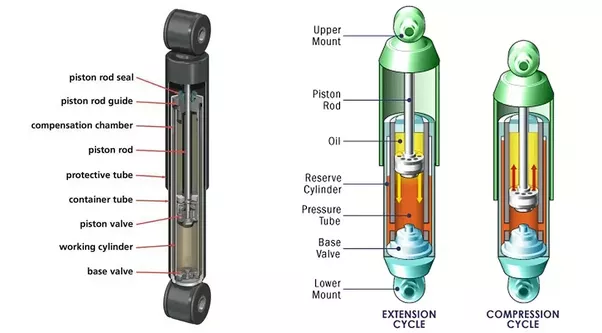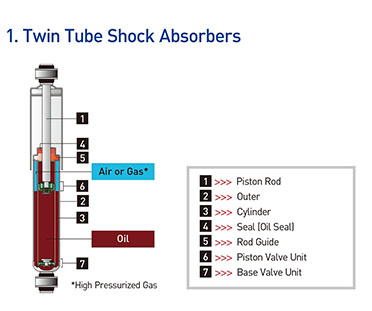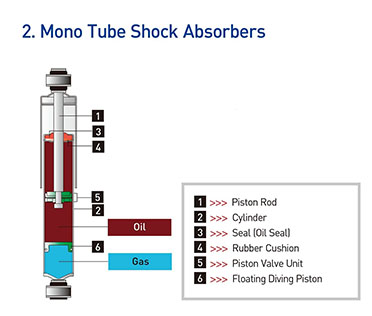Los amortiguadores son básicamente bombas de aceite. Un pistón está fijado al extremo del vástago del pistón y actúa contra el fluido hidráulico en el tubo de presión. A medida que la suspensión sube y baja, el fluido hidráulico pasa a través de pequeños orificios, llamados orificios, dentro del pistón. Sin embargo, estos orificios sólo dejan pasar una pequeña cantidad de líquido a través del pistón. Esto desacelera el pistón, lo que a su vez desacelera el movimiento del resorte y la suspensión.
Todos los amortiguadores modernos son dispositivos de amortiguación hidráulica sensibles a la velocidad, lo que significa que cuanto más rápido se mueve la suspensión, más resistencia proporciona el amortiguador.
Gracias a esta característica, los amortiguadores se ajustan a las condiciones de la carretera. Como resultado, los amortiguadores reducen la tasa de:
- Rebotar
- Rodar o balancearse
- Zambullida con freno y sentadilla con aceleración
Los amortiguadores funcionan según el principio de desplazamiento de fluido tanto en el ciclo de compresión como en el de extensión. Un automóvil o camioneta típico tendrá más resistencia durante su ciclo de extensión que durante su ciclo de compresión. El ciclo de compresión controla el movimiento del peso no suspendido de un vehículo, mientras que la extensión controla el peso suspendido más pesado.
FUNCIONES DEL AMORTIGUADOR
La función principal del amortiguador es absorber los impactos y amortiguarlos lo antes posible para que se pueda obtener una conducción suave.

Algunas otras funciones importantes del amortiguador son
Limita el movimiento de la carrocería del vehículo.
Estabiliza nuestro viaje como se mencionó anteriormente.
Estabiliza los neumáticos del vehículo que se alteran debido a un impacto repentino, por lo que también es muy importante por motivos de seguridad.
También minimiza el desgaste de los neumáticos y la carrocería del automóvil y, por lo tanto, reduce el costo general de mantenimiento.
Puede parecer un trabajo sencillo, pero esto es lo principal de lo que depende el nivel de comodidad de su viaje.
PRINCIPIO DE FUNCIONAMIENTO
Para entender el amortiguador, es muy importante entender su funcionamiento.
En primer lugar debemos saber que generalmente existen dos tipos de amortiguadores uno es hidráulico y otro es neumático. Sin embargo, el funcionamiento de ambos tipos de amortiguadores es el mismo.
Un amortiguador generalmente está acoplado a un resorte, que convierte ondas de choque repentinas en movimiento oscilatorio. Este movimiento oscilatorio nos brinda un alivio instantáneo del impacto, pero nadie puede recorrer todo el recorrido con estas oscilaciones.
Aquí surge la necesidad de un amortiguador, que se utiliza para amortiguar las oscilaciones que producen los resortes.
Un amortiguador general contiene un pistón perforado en una cámara hidráulica. La cámara está totalmente sellada por lo que si el pistón tiene que hacer algún movimiento la única manera es dejar pasar el líquido hidráulico a través de él.
Cuando se produce un choque, el pistón tiene que moverse debido al choque. Cuando el pistón se mueve, el líquido hidráulico del amortiguador tiene que pasar a través de él.
Cuando el líquido pasa a través de los diminutos orificios perforados del pistón, el pistón tiene que trabajar un poco contra él. Ese trabajo se realiza a expensas de la energía generada debido al choque y, por lo tanto, pronto el amortiguador pierde toda la energía del choque, lo que resulta en una marcha suave y sin oscilaciones.
TIPOS DE DISEÑO DE AMORTIGUADORES

Actualmente se utilizan varios diseños de amortiguadores:
Diseños de doble tubo
- Gas cargado
- PSD (amortiguación sensible a la posición)
- ASD (amortiguación sensible a la aceleración)
- Monotubo

A. Tubo doble: diseño cargado con gas
La función principal de la carga de gas es minimizar la aireación del fluido hidráulico. La presión del gas nitrógeno comprime las burbujas de aire en el fluido hidráulico. Esto evita que el aceite y el aire se mezclen y formen espuma. La espuma afecta el rendimiento porque se puede comprimir, pero el fluido no. Con la aireación reducida, el amortiguador puede reaccionar más rápido y de manera más predecible, lo que permite un tiempo de respuesta más rápido y ayuda a mantener el neumático firmemente plantado en la superficie de la carretera.
Ventajas:
- Mejora el manejo al reducir el balanceo, el balanceo y la caída.
- Reduce la aireación y ofrece un mayor rango de control sobre una variedad más amplia de condiciones de la carretera en comparación con las unidades sin gasolina.
- Menor desvanecimiento: los amortiguadores pueden perder capacidad de amortiguación a medida que se calientan durante el uso. Los amortiguadores cargados con gas podrían reducir esta pérdida de rendimiento, llamada desvanecimiento
B. Tubo doble – Diseño PSD
Los ingenieros de conducción tuvieron que hacer concesiones entre válvulas suaves y válvulas firmes. Con válvulas suaves, el fluido fluye más fácilmente. El resultado es una marcha más suave, pero con un manejo deficiente y mucho balanceo. Cuando la válvula es firme, el fluido fluye con menos facilidad. Se ha mejorado el manejo, pero la marcha puede volverse dura.
Con la llegada de la carga de gas, los ingenieros de viajes pudieron abrir los controles de orificio de estas válvulas y mejorar el equilibrio entre la comodidad y las capacidades de control disponibles en los amortiguadores tradicionales sensibles a la velocidad.
Un salto más allá del control de la velocidad del fluido es una tecnología avanzada que tiene en cuenta la posición de la válvula dentro del tubo de presión. Esto se llama amortiguación sensible a la posición (PSD).
La clave de esta innovación son las ranuras cónicas de precisión en el tubo de presión. Cada aplicación se ajusta individualmente, adaptando la longitud, profundidad y conicidad de estas ranuras para garantizar una comodidad de marcha óptima y mayor control. En esencia, esto crea dos zonas dentro del tubo de presión.
La primera zona, la zona de confort, es donde se realiza la conducción normal.
La segunda zona, la zona de control, se utiliza durante situaciones de conducción exigentes.
Ventajas:
- Permite a los ingenieros de conducción ir más allá de la simple válvula sensible a la velocidad y utilizar la posición del pistón para ajustar la característica de conducción.
- Se ajusta más rápidamente a las condiciones cambiantes de la carretera y del peso que los amortiguadores estándar
- Dos amortiguadores en uno: comodidad y control
C. Tubo doble: diseño ASD (réflex)
Un nuevo giro en el compromiso comodidad/control es una tecnología innovadora que proporciona un mayor control para el manejo al tiempo que mejora la comodidad de marcha llamada Amortiguación Sensible a la Aceleración (ASD).
Esta tecnología va más allá de la amortiguación tradicional sensible a la velocidad para enfocar y abordar el impacto. Este enfoque en el impacto se logra mediante la utilización de un nuevo diseño de válvula de compresión. Esta válvula de compresión es un sistema mecánico de circuito cerrado que abre un bypass para que el fluido fluya alrededor de la válvula de compresión.
Ventajas:
- Se mejora el control sin sacrificar la comodidad del conductor
- La válvula se ajusta automáticamente a los cambios en las condiciones de la carretera
- Reduce la dureza de la marcha
- Diseño monotubo (tipos estándar)
Se trata de amortiguadores de gas a alta presión con un solo tubo, el tubo de presión. Dentro del tubo de presión hay dos pistones: un pistón divisor y un pistón de trabajo. El pistón y la varilla de trabajo son muy similares al diseño del amortiguador de doble tubo. La diferencia en la aplicación real es que un amortiguador monotubo se puede montar boca abajo o boca arriba y funcionará de cualquier manera. Además de su flexibilidad de montaje, los amortiguadores monotubo son un componente importante, junto con el resorte, para soportar el peso del vehículo. Otra diferencia que puedes notar es que el amortiguador monotubo no tiene válvula de base. En cambio, todo el control durante la compresión y extensión se realiza en el pistón.
Durante la operación, el pistón divisor se mueve hacia arriba y hacia abajo a medida que el vástago del pistón entra y sale del amortiguador, manteniendo el tubo de presión lleno en todo momento.
Ventajas:
- Puede montarse boca abajo, lo que reduce el peso no suspendido
- Puede funcionar a menor temperatura ya que el tubo de trabajo está expuesto al aire
- Equipo original en muchos vehículos de pasajeros, SUV y camionetas livianas nacionales importados y de alto rendimiento.


